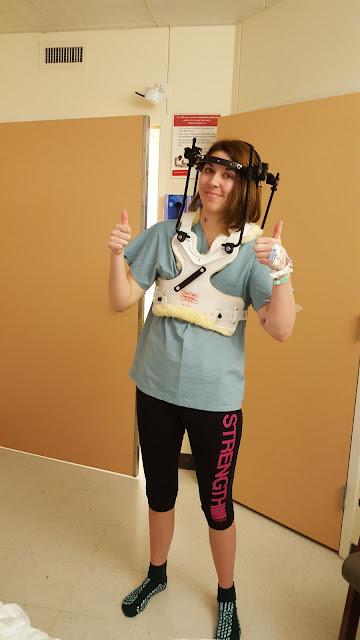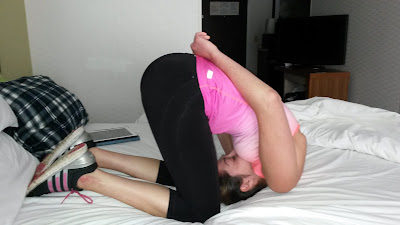April 6, 2016
When I woke up the morning after the halo application on April 6th, I felt like I was almost in a dream. There was ZERO pain in my neck...not to say there wasn't pain in my skull at the pin sites. It was an unbelievable, surreal feeling. For the past few years I had been telling my physical therapists and my doctors all I need is something, or somebody, to hold my head up 24/7 so I could get some neck pain relief, and function restored to my R shoulder. As crazy as it sounds, I knew exactly what a halo brace was. I had read about them through my own readings and I remember saying to my family I was willing to let somebody screw a brace into my skull for a short period of time as a test to see if in fact I got relief. To my surprise, the halo brace was recommended to me a couple years down the line and it did just that. It provided relief. Dr. F told me I was the first patient that he has ever had that told him that that they had instant relief in their neck once the halo was applied. That was a pretty good indicator to everybody that there is something wrong and a fusion would be beneficial. Next thing I knew, I was scheduled to have my neck fused one week later on April 12th.
 |
| I'm not saying that I had no pain in my body, but to have that horrid, sharp, stabbing, neck pain gone was unbelievable |
The video below was taken in Fall 2014. My neck moved more "normal" in this video than it did up until surgery two weeks ago. This video shows how much motion I had in my R shoulder with my neck in a neutral position vs. a flexed position.
In case the video below doesn't work, here's the same video on Youtube: R Shoulder Increase with Neck Hyperflexion
I'm not one to take selfies of myself, but that morning I felt a selfie was warranted. I wanted to take a picture of myself smiling because I can't remember the last time I woke up in the morning and thought I looked relatively good considering I just had the halo applied to my head the day prior. I was smiling ear to ear because I had less pain, there were no furrow lines between my eyebrows, and my doctor helped me. What could be better? Even though my gut feeling was that the halo was going to help, there is always that little part of you that worries and asks, "What if this doesn't work? What if I feel worse? What if I put myself through this all for nothing?" The fact that none of those worries occurred was big enough reason all in itself to smile!!
 |
| So happy to be feeling well overall. When you live with chronic pain all over your body, it is amazing how much better you feel by getting rid of just one area of pain. |
A little bit later I called my nurse in because I needed to use the restroom. This was going to be the first true test. Would I be able to get out of bed, and walk to the bathroom? I wondered what it would feel like having this big halo on top of my head and having to learn to walk with it. My body would have to adjust to the added weight and find its new center of balance. I had an additional challenge as well because I have such minimal use of my arms. I didn't have the luxury to push myself up with my arms to a standing position. Instead I hooked my feet on the side railings of the bed and used my abs to sit straight up. From there I slowly turned so my feet were on the ground. Instinct for anybody helping you to a standing position is to automatically grab your arms to help you up. Each time I had to say, "No, no, you can't grab my arms. I have to make sure I have my balance. Just stand around me in case I don't have my balance and start to fall." The first time I stood up I was dizzy. I was not expecting that. My mom was on my left, and the nurse was on my right. Both were holding me at my waist until I found my balance. It didn't take very long for the dizziness to go away, and I gave the go ahead to help me walk to the bathroom and I stayed on both feet the whole time! When I walked out of the bathroom, I wanted to see if I was able to stand by myself on both feet unassisted. Guess what?!? I did it and I was thrilled!
 |
| Don't underestimate the baby steps You can't see them in the picture, but there were people VERY close by to help me if need be. |
This was the next goal on my list. The nurses told me as long as somebody was with me, I was allowed to walk short distances. So my mom and dad came with me. My mom had the camera so she captured this moment of my dad and I.
 |
| My dad and I walking the halls |
 |
| Just smiling in the hallway. I didn't realize it at the time I grabbed these pants, but it says STRENGTH on the outside of my left leg. |
 |
| I was sound asleep. It was the most comfortable that I could get. The plus of the halo, is your head doesn't fall forward when you fall asleep. The down side is your mouth drops open a little bit :) |
Later that afternoon I wanted to try sitting in the hospital chair. For me, I was more comfortable putting a pillow vertically behind my back so there was more cushion. Unfortunately these chairs didn't have high backs so I couldn't sit in them very long. When I was at home though I was able to re-position my pillows differently on the higher back chairs to make myself more comfortable.
Some of you may be wondering how in the world we got that shirt off underneath my halo when it came time to change. My neurosurgeon, Dr. F went searching for a shirt of any kind on the operating room floor so I could put it on before the halo was applied. We didn't care what type of shirt it was. When I got home, and it was time to change, there was no way for me to get the scrub shirt off without my mom cutting it with scissors. In hindsight I should have taken a picture of the cut up blue scrub shirt.
At my appointment with my geneticist in March a couple of weeks before the halo application and then the fusion surgery, he warned me that people who do not have shoulder problems end up with really bad muscle spasms due to being fixed in a new position. He then said, "Since your shoulders are crap, the likelihood of this happening to you is quite high and you'll experience this worse than the average person." He then went on to tell me that I may require additional bracing for my shoulders, and I will need to be on muscle relaxers to try to tame the beast. He wasn't kidding about that, and was spot on. It has been a daily battle since I got the halo on.
 |
* *If you have a Facebook account, click here and "LIKE" my page: Meg's EDS Medical Journey
** Follow me on Instagram: https://www.instagram.com/thetravelinghaloofhope/
If anybody has Ehlers-Danlos Syndrome, who was, or is in a halo and would like to connect, please email me at kingmeg19@gmail.com












